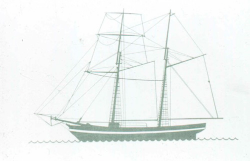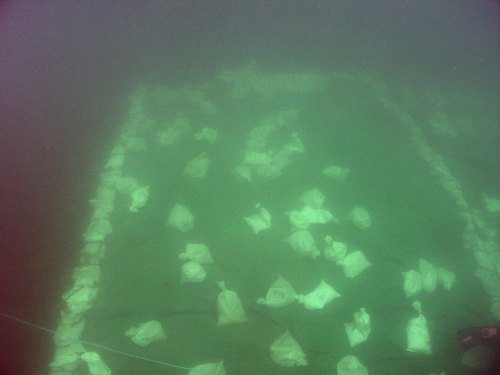During my directed study, I’ve been researching 18 shipwrecks lying in Victorian state waters. I’ve researched the history of shipwreck significance, worked out how shipwreck significance is assessed and begun the process of assessing significance for some of those wrecks.
Some shipwrecks have turned out to be significant because of the events surrounding their working lives, some because of the results of the studies of archaeologists examining their wrecks. Either way the waters of Port Phillip and the surrounding Victorian coastline shelter some very interesting shipwrecks.
Here’s just a taste:
Loch Ard is one of the most famous shipwrecks in Victoria. A three-masted square-rigged iron sailing ship, Loch Ard left England on 2 March 1878 with a general cargo of luxury items and industrial loads of railway iron and cement. On 1 June, the ship was only a day or two out from Melbourne near Cape Otway when heavy fog descended.

Loch Ard. Image courtesy Heritage Victoria
When the fog lifted, the Captain, instead of clear ocean and a distant shoreline, was faced with sheer cliffs and breaking waves. I can’t even begin to imagine what that felt like. The ship hit the reef just off Mutton Bird Island and large waves caused the masts and rigging to crash down so the lifeboats couldn’t be launched successfully. Tom Pearce, one of the crew, and passenger Eva Carmichael were the only two on board who survived (Lomdahl 1992).
Just five bodies (out of 47) were ever recovered. Eva lost all her immediate family and would have died herself if Tom Pearce hadn’t come to her rescue. If life were a Hollywood movie, Eva and Tom, both eighteen, would have sailed happily off into the sunset. Society of the day certainly thought they should at least get married since they had spent time alone, drinking brandy before Tom went to find help (ignoring the fact it was dark, cold and Tom needed to catch his breath before attempting to climb the cliffs). But it wasn’t Hollywood and instead Eva went back to Ireland and married a Captain Townsend while Tom went back to the sea. Ironically, Eva and her husband moved to the Irish coast where she was called on to help shipwreck survivors … one of whom (apparently) turned out to be Tom Pearce (The Argus 16 June 1934). This is a Hollywood script just crying out to be written.

Image courtesy Victorian Collections.
A few days after the wreck, a crate containing a large ceramic peacock was washed ashore in Loch Ard Gorge. The Minton Loch Ard Peacock is one of the more famous pieces of cargo saved from the wreck. The porcelain statue, valued at over $4 million, is one of only nine still existing worldwide and was arriving in Australia to be displayed at the 1880 Melbourne International Exhibition. It finally got its chance to shine at the 1988 Brisbane World Expo. The peacock is currently on display at the Flagstaff Hill Maritime Museum in Warnambool, Victoria.
Then there’s Clarence, a small coastal wooden sailing ship, indistinguishable from many vessels plying their trade around the southern coast of Australia during the 1840s and 1850s. Clarence sailing past would have been a bit like watching a semi-trailer driving down the highway. You might idly wonder what it was carrying before it disappeared from view; then again you might not. However, Clarence’s brief and unglamorous career as a small trading schooner belies its subsequent importance to archaeological and historical studies of undocumented Australian shipbuilding (Harvey 1989).

Clarence line drawing. Image courtesy Heritage Victoria
I’m sure Clarence’s builders from the Williams River in NSW never imagined their work would be so scrutinised. Remember people, whatever you build today may be examined in 200 years by an archaeologist trying to piece together your work … make sure it’s good (or if you want to have some fun, make it cryptic)!
Clarence is currently the subject of an Australian Research Council grant studying the excavation, reburial and in-situ preservation of shipwrecks and their artefacts. I was fortunate enough to be a volunteer when, in 2012, Clarence was excavated, wrapped in geo-textile, covered in shade cloth and tarpaulin and weighed down by 3,500 sandbags. As a result, Clarence may still be there for archaeologists to study in 1000 years time and I can now add ‘professional sandbag filler’ to my resumé.

A small section of Clarence reburial …. Image Jon Carpenter
One vessel not often in the public eye is the clipper ship, Schomberg. Schomberg had no statement of significance in the Victorian database and when I started researching I had no idea what I’d discover. What I did find was a tale of pride, scandal and narrowly avoided tragedy. Schomberg’s story was almost the nineteenth century’s version of Titanic: built at great expense, labeled the most perfect clipper ship ever built, designed to be the most comfortable, luxurious and fastest vessel to sail to Melbourne—and it sank on its maiden voyage in 1855. Fortunately, the steamer SS Queen was close enough to come to the rescue of the 430 passengers and crew.

Captain ‘Bully’ Forbes. Image courtesty Project Marco Polo
The Captain, ‘Bully’ Forbes, was charged in the Supreme Court with negligence because of the suspicion that he was playing cards with two female passengers below decks while his ship ran aground. None of the passengers spoke terribly highly of him, complaining that he strutted the deck with a loaded revolver and that half-naked women were emerging from his cabin at all hours of the night. Despite a protest meeting, two inquiries and the court proceedings, he was found not guilty and cleared of all charges on the grounds of insufficient evidence (Uhl 1985:24).
As an aside, Schomberg was built using the ‘diagonal principle’: its frame was British oak with layers of Scottish larch fitted diagonally to the frames, apparently the same design as Queen Victoria’s newly acquired yacht. Interestingly, pieces of hull with this distinctive design feature were washed up on the New Zealand coast and were thought to be a part of Schomberg‘s hull (Lomdahl 1992).
The clipper ship, Schomberg. Image courtesy Heritage Victoria.
This is just a brief journey through three Victorian shipwreck histories that grabbed my attention, there is more to tell for each but space is brief. While it takes more than just romance, scandal and maritime archaeology to make a vessel significant, each adds to the fabric of the story that makes up the life and wreck of a ship.
References
Harvey, P. 1989 Excavation of the Shipwreck Clarence: Port Phillip Bay October 1987. Victoria: Victoria Archaeology Survey, Maritime Heritage Unit.
Lomdahl, A., 1992 Underwater Shipwreck Discovery Trail. Victoria: Victoria Archaeological Survey, Maritime Archaeological Unit.
Mosely, M. 1934 ‘Eva Carmichael and Tom Pearce. Why they did not marry.’ The Argus (Melbourne, Vic.:1848-1957), 16 June, p. 4, retrieved 13 October 2013, http://trove.nla.gov.au/ndp/del/article/10947161
Uhl, J. 1985 Sailing Ships, Shipwrecks and Crime in the 19th Century: A Handbook for Historians, Genealogists, Shiplovers and Criminologists based on Supreme Court Records, Criminal Sessions 1840s-1860s. Oakleigh, Victoria: Australian Institute of Genealogical Studies.

